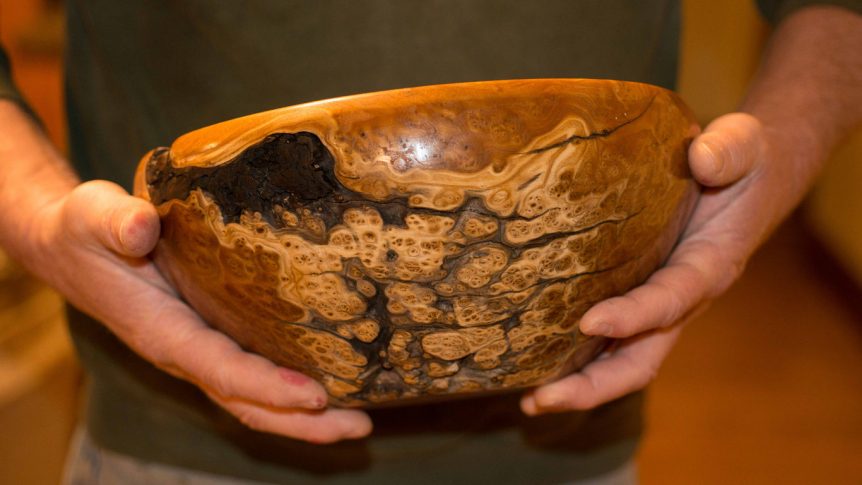Losing a beloved tree can be an emotional experience. Trees stand sentinel in our yards and have decades, even centuries of memories wound up in the beautiful swirling grains of their wood. In generational properties they may have been planted by a grandparent or a great grandparent, or to mark the birth of a baby. Or maybe they’ve just provided a favorite place for relaxation over the years.
When these pillars of strength fall victim to disease, a storm, or give way to other improvements it can be tough to let them go. But you don’t necessarily have to. Many backyard trees are a woodworker’s delight. Their sturdy bases and reaching branches can be fashioned into keepsake items from furniture to bowls to the smallest of notions in the hands of skilled craftsmen to continue their lives with the family.
Andrew Bishop has been harvesting trees past their prime and usefulness from his family farmstead and backyards and farmsteads across Montana to create beautiful furniture he sells through his company River Bottom Restoration Furniture. Many of trees he works with are culled from the thousands planted by his own grandparents to protect their homestead from the relenting winds of the vast Montana prairie. While he specializes in the unique and nearly impossible to manage Russian olive, he notes there are plenty of backyard trees woodworkers would be happy to tackle.
“There are so many domestic woods wasted every year by people burning them for firewood, having them chipped, or sent to the landfill,” Bishop says. “There’s a use for almost every domestic wood.”
He lists green ash as a beautiful and very hard wood, Osage orange, black walnut, locust, elm, willow, apple, oak, or even pine, and the list goes on. “Basically, if you can categorize it as a hard wood there is value there. If it’s a wood like black walnut or maple you can probably even sell it for a premium. If it’s another hard wood, an artisan may come help you cut down the tree, remove it, and possibly even give you back something they’ve created from the wood,” Bishop says. Woods such as the streaked red tones found in apple are prized to wood turners.
Plan For Use
If a tree is to be used by a woodworker, it’s important to take care when cutting it down. Bishop makes a lot of large tables, such as dining room or conference tables, which require large pieces of wood.
“The tree should be cut in as long of lengths as possible and in the widest diameter possible,” Bishop says. “The largest sections of the trunk are the most valuable and the easiest to make things from.”
When he makes a table, he wants an 8-foot section that is uniformly 24 inches in diameter. That will provide the pieces for a decently wide and long table by joining just two slabs.
“If you have someone coming in to cut up the tree, make sure they don’t cut pieces less than 8-feet long if possible. You don’t want any unnecessary cuts. This applies not only to the trunk, but to large limbs, too. Limbs can be made into beautiful coffee tables or other small items,” Bishop says. If a roughly 4-foot coffee table is the goal, he says limbs should be cut in 6-foot sections as some wood can be lost to “checking” or cracking at the ends of the slabs.
“Even the smaller limbs are of value. Wood turners like smaller limbs for turning bowls and that’s a cheaper way to get a keepsake of a tree as opposed to commissioning a table from the stump,” Bishop says.
Woodworkers also prize burls. A burl is deformation caused when the tree suffers and injury or disease creating a thick mass, sort of a knot, that features unique and highly desirable wood grain patterns. “If you have a burl, you’ll want to keep it intact. They can be worth a lot and produce really beautiful pieces,” Bishop says. His father is skilled at the lathe and has turned fantastically interesting and unique bowls from burls Bishop has found in the trees he harvests for tables and other large pieces of furniture.
Be Patient
Trees are slow to grow and slow in their journey to becoming tables, shelves, mantles, bowls, and other beautiful keepsakes. It takes years before the wood is ready to be worked.
“You’re not going to have immediate satisfaction,” Bishop warns. If the tree is living, it will take roughly 2 years, depending on the size of the tree, for it to dry out and cure. “Trees will dry 2 inches from the outside each year in most environments, which means 4-inches of dried wood per year. If it’s a 36-inch diameter tree, it’s going to take some time to dry out.”
For his Russian olive creations, Bishop usually allows a 2-year dry time before cutting slabs from the logs and then lets the slabs dry another 6 months. “There’s a lot of tension built up in the logs, it takes a long time for them to expand and settle,” he says.
The resulting wood products are well worth the wait. So, when it’s time to take down a tree, take the extra step to call in local artisan woodworkers or sawyers (sawmill operators) to see if there’s value in the tree. Consider hiring these same folks to craft some unique family heirlooms allowing a treasured tree to continue holding a place in the lives and hearts of the family.
Helpful links:

